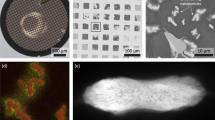Abstract
WHILE devising a microscopic test for the detection of small particles of metallic iron it was discovered that blue whisker-like structures (Fig. 1) were formed from iron particles or iron alloys in a 10 per cent (w/w) solution of acidified (0.06 N hydrochloric acid) potassium ferricyanide. Further microscopic examination of these structures revealed them to be hollow tubes. Considerable branching of these tubules was also evident, giving a general appearance not unlike that of fungal mycelium. Growth of these tubules proceeds at the tip, and the rate of growth, the diameter of the tubules, the amount of branching and shape of the tubules appear to be directly related to the concentration of ferricyanide and the type of iron alloy. With powdered iron, for example, in a 10 per cent concentration of acidic ferricyanide, the tubules vary from about 4 to 10µ in diameter. They may grow outward from the iron particles to a distance of from 0. to 0.5 mm or longer within a second. In less than 30 sec most of the tubules have formed, many of them bent or looped, or both. At a ferricyanide concentration of 5 per cent (w/w) the tubules are more variable, larger in diameter, and grow much longer. At concentrations of 2–2.5 per cent the tubules grow more slowly, some of them forming a blue precipitate at the end which slowly drifts away giving the appearance of smoke coming out from a lengthening smokestack. At concentrations of 20 per cent (w/w) and higher, a few tubules may be seen but mostly blue hemispherical and spherical structures are formed on the surface of the iron. If the solution is then diluted, tubules may be seen to arise from these structures. The tubules formed from acidic ferrocyanide and iron appear to be lighter blue or green in colour.
This is a preview of subscription content, access via your institution
Access options
Subscribe to this journal
Receive 51 print issues and online access
$199.00 per year
only $3.90 per issue
Buy this article
- Purchase on Springer Link
- Instant access to full article PDF
Prices may be subject to local taxes which are calculated during checkout
Similar content being viewed by others
References
Butler, G., and Ison, H. C. K., Nature, 182, 1229 (1958).
Author information
Authors and Affiliations
Rights and permissions
About this article
Cite this article
IVERSON, W. Formation of “Hollow Whiskers” from Metals by Reaction with Ferricyanide and Ferrocyanide. Nature 213, 486–487 (1967). https://doi.org/10.1038/213486a0
Received:
Issue Date:
DOI: https://doi.org/10.1038/213486a0
Comments
By submitting a comment you agree to abide by our Terms and Community Guidelines. If you find something abusive or that does not comply with our terms or guidelines please flag it as inappropriate.



